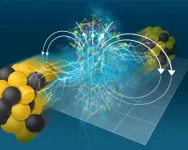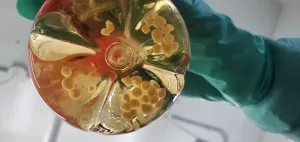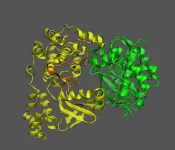(Press-News.org) New initiative, launched on World NF Awareness Day, focuses on developing improved models to understand neurofibromatosis type 1 (NF1) with the goal of rapidly testing new treatments.
18 grants will be provided to leading medical research institutions in the United States and Europe.
The Next-Generation NF1 Models Initiative is the Foundation’s fourth research initiative focused on accelerating a cure for neurofibromatosis.
DETROIT, May 17, 2024 – Gilbert Family Foundation, a private foundation established by Dan and Jennifer Gilbert to accelerate a cure for neurofibromatosis type one (NF1) and build opportunity in the city of Detroit, today announced $21 million in grants to launch the Next-Generation NF1 Models Initiative. The $21 million investment will support 18 unique research grants representing distinguished researchers from leading universities and medical research institutions in the United States and Europe.
The creation of the Next-Generation NF1 Models Initiative addresses the need for more advanced models of the NF1 disease, which are key to developing improved treatments. It follows three other research initiatives developed by Gilbert Family Foundation: the Vision Restoration Initiative, Brain Tumor Initiative and Gene Therapy Initiative. The Foundation and sister nonprofit, NF Forward, has committed more than $125 million into research to cure neurofibromatosis.
“NF1 affects about one in 2,500 births, meaning millions of people worldwide experience debilitating and occasionally life-threatening symptoms including blindness, deafness, tumors and more,” said Jennifer Gilbert, Co-Founder of Gilbert Family Foundation. “Those who face NF inspire us every day to identify more innovative approaches to this challenging disease. These investments will accelerate the discovery of treatments that address both the symptoms and underlying cause of neurofibromatosis.”
The 18 research grants were selected after rigorous peer review following an open request for proposals issued in early 2023. The funded projects will develop innovative NF1 preclinical models that will enable more robust NF1 drug discovery and translation into human clinical trials.
These projects place a special emphasis on organoid, assembloid, and other in vitro 3D tissue and organ models, which are organ-like assemblies of tissues grown in a lab environment. These models add depth to mechanistic studies, which focus on the mechanism of action for a disease. They are also more tractable to drug screening, meaning researchers can more easily test whether a drug is more likely to be effective on any given disease target. The research initiative will also include some next generation in vivo models focused on NF1-associated brain tumors, peripheral tumors and behavioral manifestations related to the disease.
“I’m grateful to the Gilbert Family Foundation for their crucial grant supporting our research in understanding neurofibromatosis,” said Dr. Jürgen Knoblich, PhD, Austrian Academy of Sciences. “With this funding, we aim to develop an advanced brain organoid model, a steppingstone for discovering anti-tumor drugs and advancing neurofibromatosis treatments.”
The full list of researchers include:
Budd A. Tucker, PhD, University of Iowa
Cherry Gupta, PhD, Battelle Memorial Institute
David Gutmann, MD, PhD, Washington University, St. Louis
David Solomon, MD, PhD, University of California, San Francisco
David Wood, PhD, University of Minnesota
Eric Raabe, MD, PhD, Johns Hopkins University
Evelin Schröck, MD, University Hospital Carl Gustav Carus at the TU Dresden, Germany
Gabsang Lee, PhD, Johns Hopkins University
Gregory Way, PhD, University of Colorado Anshutz
Jason Meyer, PhD, Indiana University
Jürgen Knoblich, PhD, Institute of Molecular Biotechnology, Austrian Academy of Sciences, Austria
Michelle Mattson-Hoss, PhD, Infixion Bioscience
Nereo Kalebic, PhD, Human Technopole, Italy
Piotr Topilko, PhD, IMRB, France
Rebecca Dodd, PhD, and Dawn Quelle, PhD, University of Iowa
Robert Kesterson, PhD, Pennington Biomedical Research Center
Sergiu Pasca, MD, Stanford University
Silmara de Lima, PhD, Boston Children’s Hospital, Harvard University
Xitiz Chamling, PhD, Johns Hopkins University
The preclinical models generated in these projects will ultimately be hosted at the Nick Gilbert Neurofibromatosis Research Institute (NGNRI) when it opens in 2027. NGNRI is a new research institute announced in September 2023 that will be headquartered in Detroit as part of Henry Ford Health + Michigan State University’s new research building.
NGNRI will be the first brick-and-mortar institute solely dedicated to neurofibromatosis, and one of the first institutes to leverage organoid technology and other novel models to address a single disease. It was named after Dan and Jennifer’s son, Nick Gilbert, who passed away from complications associated with NF1 in May 2023.
###
About Gilbert Family Foundation:
Gilbert Family Foundation is a private nonprofit foundation founded by Jennifer and Dan Gilbert to accelerate a cure for neurofibromatosis type 1 (NF1) and build economic opportunity and equity in the city of Detroit. Gilbert Family Foundation supports groundbreaking, cutting-edge research in hopes of eradicating NF1, a genetic disorder that causes tumors to grow on nerves anywhere in the body. Additionally, the Foundation supports the economic stability and mobility of residents in Detroit by investing in wealth-building opportunities and breaking down systemic barriers. For more information on Gilbert Family Foundation, please visit gilbertfamilyfoundation.org.
About the Nick Gilbert Neurofibromatosis Research Institute:
The Nick Gilbert Neurofibromatosis Research Institute (NGNRI) is the world’s first brick-and-mortar research facility solely focused on finding a cure for neurofibromatosis or NF. Named in memory of Nick Gilbert, who passed away from complications related to NF in 2023, NGNRI seeks to discover and develop improved treatments and cures for neurofibromatosis type 1 and other debilitating neuronal diseases and related conditions. NGNRI paves the way for more personalized health care by leveraging next generation technologies, including ‘organoids’ or organ-like assemblies of tissues grown in a lab environments, and advancing leading research. NGNRI will be housed within the Henry Ford Health + Michigan State University Health Sciences research campus.
END
Gilbert Family Foundation invests $21 million to launch new research initiative focused on developing advanced disease models to accelerate cure for neurofibromatosis
2024-05-17
ELSE PRESS RELEASES FROM THIS DATE:
Multiple onychopapillomas and BAP1 tumor predisposition syndrome
2024-05-17
About The Study: This study found that BRCA1-associated protein (BAP1) tumor predisposition syndrome was associated with a high rate of nail abnormalities consistent with onychopapillomas (a benign tumor of the nail) in adult carriers of the disease. Findings suggest that this novel cutaneous sign may facilitate detection of the syndrome in family members who are at risk and patients with cancers associated with BAP1 given that multiple onychopapillomas are uncommon in the general population and may be a distinct clue to the presence of a pathogenic germline variant in the BAP1 gene.
Corresponding Authors: To contact the corresponding authors, ...
Researchers confirm scale matters in determining vulnerability of freshwater fish to climate changes
2024-05-17
The silver chub isn’t considered sensitive to climate change on a national scale, but context matters. For example, if climate change sensitivity is evaluated in only one region of the United States, the freshwater fish appears quite a bit more susceptible.
“Relative to other species we looked at in the gulf region of the U.S., the silver chub occupied a pretty small geographic area,” said Samuel Silknetter, a Ph.D. student in biological sciences. “If we didn’t look at the climate sensitivity across multiple ...
Sweet taste receptor affects how glucose is handled metabolically by humans
2024-05-17
PHILADELPHIA (May 16, 2024) – The rich research portfolio of the Monell Chemical Senses Center on sweet taste goes way back: Monell scientists were one of four teams in 2001 that found and described the mammalian sweet taste receptor – TAS1R2-TAS1R3. Twenty years later in 2021, a pair of papers published in Mammalian Genome by Monell researchers covered the genetics of sugar-loving mice.
The sweet taste receptor, expressed in taste bud cells, conveys sweetness from the mouth when it is activated. Earlier this month, a study in PLOS One, led by another Monell researcher, delved into how the sweet-taste receptor might be the first stop ...
STAR sees a magnetic imprint on deconfined nuclear matter
2024-05-17
The Science
Scientists have the first direct evidence that the powerful magnetic fields created in off-center collisions of atomic nuclei induce an electric current in “deconfined” nuclear matter. This is a plasma “soup” of quarks and gluons that have been set free, or “deconfined,” from nuclear matter—protons and neutrons—in the particle collisions. The magnetic fields in deconfined nuclear matter are a billion times stronger than a typical refrigerator magnet, but their effects can be hard to detect. This new study’s evidence is from measuring the way ...
CU faculty member receives prestigious award for health equity work
2024-05-17
In recognition of her exceptional work in advancing health equity, the Society of General Internal Medicine (SGIM) bestowed its 2024 Herbert W. Nickens Award to Rita Lee, MD, a University of Colorado Department of Medicine faculty member, at a May 17 meeting in Boston.
“The committee has chosen to honor you as an exemplary SGIM member who has made prioritizing minority health and diversity the primary focus of your career,” Alana Biggers, MD, MPH, the chair of the award selection committee, said in a congratulatory letter to Lee.
The ...
Better medical record-keeping needed to fight antibiotic overuse, studies suggest
2024-05-17
A lack of detailed record-keeping in clinics and emergency departments may be getting in the way of reducing the inappropriate use of antibiotics, a pair of new studies by a pair of University of Michigan physicians and their colleagues suggests.
In one of the studies, about 10% of children and 35% of adults who got an antibiotic prescription during an office visit had no specific reason for the antibiotic in their record.
The rate of this type of prescribing is especially high in adults treated seen in emergency departments and in adults seen in clinics who have Medicaid coverage or no insurance, the ...
Clinicians report success with first test of drug in a patient with life-threatening blood clotting disorder
2024-05-17
Key Takeaways
Immune thrombotic thrombocytopenic purpura, a rare blood clotting disorder, results from an autoimmune attack against an enzyme called ADAMTS13
A recombinant form of human ADAMTS13 approved for a different condition helped to save the life of a young mother with immune thrombotic thrombocytopenic purpura
Results from this first use of the drug for this condition—by a team led by researchers from Massachusetts General Hospital—warrants testing the drug in a clinical trial
A team led by investigators from Massachusetts General Hospital, a founding member of the Mass General Brigham healthcare system, used a new drug to save the life of a patient ...
NIH study shows chronic wasting disease unlikely to move from animals to people
2024-05-17
WHAT:
A new study of prion diseases, using a human cerebral organoid model, suggests there is a substantial species barrier preventing transmission of chronic wasting disease (CWD) from cervids—deer, elk and moose—to people. The findings, from National Institutes of Health scientists and published in Emerging Infectious Diseases, are consistent with decades of similar research in animal models at the NIH’s National Institute of Allergy and Infectious Diseases (NIAID).
Prion diseases are degenerative diseases found in some mammals. These diseases primarily involve deterioration of the brain but also can affect the eyes and other organs. ...
Scientists discover mechanism of sugar signaling in plants
2024-05-17
UPTON, N.Y. — Proteins are molecular machines, with flexible pieces and moving parts. Understanding how these parts move helps scientists unravel the function a protein plays in living things — and potentially how to change its effects. Biochemists at the U.S. Department of Energy’s (DOE) Brookhaven National Laboratory and colleagues at DOE’s Pacific Northwest National Laboratory (PNNL) have just published a new example of how one such molecular machine works.
Their paper in the journal Science Advances describes how the moving parts of ...
Cleveland Clinic research finds VISTA directly blocks T-cells from functioning in immunotherapy
2024-05-17
A Cleveland Clinic-led team of scientists and physicians have discovered that the immune checkpoint protein VISTA can directly turn off tumor-fighting T-cells during immunotherapy and resist treatment.
The study, published in Science Immunology, explains that VISTA can bind to a protein called LRIG1 in T cells, which was previously only thought to promote bone and fat development. When VISTA binds to LRIG1, the researchers found, LRIG1 sends signals that suppress T cell replication, survival ...




